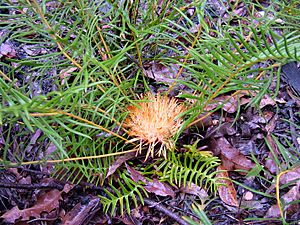Banksia pellaeifolia facts for kids
Quick facts for kids Banksia pellaeifolia |
|
|---|---|
 |
|
| Near Williams | |
| Scientific classification | |
| Genus: |
Banksia
|
| Species: |
pellaeifolia
|
| Synonyms | |
|
|
Banksia pellaeifolia is a special type of shrub. It grows only in the southwest part of Western Australia. This plant has stems that grow underground. Its leaves are deeply divided into many small parts. It has yellowish-brown flowers that grow in groups. These flowers later turn into egg-shaped seed pods.
Contents
What it Looks Like
Banksia pellaeifolia is a shrub with hairy, underground stems. These stems can survive fires. The plant usually spreads out about 1.7 meters wide. Its leaves are very unique. They are 20 to 35 centimeters long and 5 to 13 centimeters wide. Each leaf has 20 to 30 sharp, thin parts on each side.
The flowers are yellowish-brown. They grow in heads, with about 65 flowers in each head. At the bottom of the flower head are special leaf-like parts called bracts. These are about 3.5 to 4 centimeters long. The main part of the flower, called the perianth, is 4 to 4.7 centimeters long. The pistil, which is the female part of the flower, is 3.9 to 4.5 centimeters long. This plant flowers from May to August. The seed pods are egg-shaped and about 1.8 to 1.9 centimeters long. They have scattered hairs on them.
How it Got its Name
This plant was first officially described in 1810. A botanist named Robert Brown gave it the name Dryandra blechnifolia. He wrote about it in a science publication. He found specimens of the plant near King George's Sound. The name blechnifolia refers to a type of fern called Blechnum. The ending means "leaved."
Later, in 2007, two scientists, Austin Mast and Kevin Thiele, moved all Dryandra plants into the Banksia group. But there was already a Banksia plant named Banksia blechnifolia. So, Mast and Thiele gave this plant a new name: Banksia pellaeifolia. This new name refers to another type of fern called Pellaea.
Where it Grows
Banksia pellaeifolia grows in an area called kwongan. This is a type of shrubland found in Australia. You can mostly find this plant in the Stirling Range National Park. It also grows near a town called Ongerup.
Its Future and Climate Change
Scientists have studied how climate change might affect this plant. They found that the area where it grows could shrink. Its habitat might get 50% to 80% smaller by the year 2080. This depends on how much the climate changes.
Conservation Status
The Western Australian Government's Department of Parks and Wildlife says this banksia is "not threatened." This means it is not currently in danger of disappearing.

